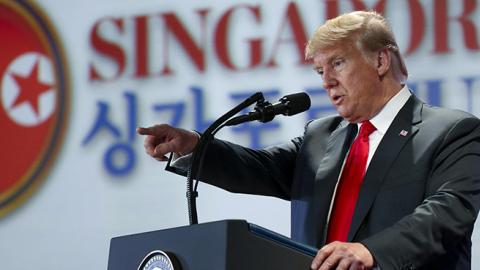Last year Kim Jong Un wagered that he could transform North Korea’s relations with the United States, South Korea and other powers. Despite months of flashy diplomacy, North Korea’s future remains hazy. The world wants to know how the long Cold War ends, but a second Trump-Kim summit will not yield closure. Retreating from his exuberance after the Singapore summit, U.S. President Donald Trump tweeted on Wednesday that denuclearization had only a “decent chance.”
While the U.S. and North Korea may appear to be set for a protracted stalemate, by the end of next year ties will head in one of two directions: Either sufficient progress is made to justify continuing rapprochement, or frustrations over the lack of substantive progress will terminate the diplomatic opening with the Kim regime.
The U.S. should not give up on diplomacy just yet. The alternatives are ugly, and there is a reason to believe that 35-year-old Kim wants to develop and modernize his country.
Without concrete denuclearization commitments, however, the Trump administration should refuse to set a date certain for a sequel summit. Even amid preparation for another tete-a-tete, the U.S. needs to position itself, along with South Korea and others, to dial up economic and diplomatic pressure on Pyongyang if it does not move beyond testing moratoriums and largely symbolic gestures around secondary elements of its weapons programs.
Preparing for failure — for the potential shocks that would accompany a breakdown in negotiations with North Korea — is just as critical as planning for success. Failure can emerge in manifold ways, ranging from Pyongyang’s foot-dragging or cheating on denuclearization steps while reaping economic benefits to a crisis-induced interruption or renewed provocations.
Should this be the pathway Kim pursues, the hardest act of leadership for the Trump administration will be to decide when to dispense with superficial peace and put an end to an anemic negotiating process.
Kim will not respond well to a diplomatic pause and heightened pressure. Because North Korea could break the interregnum with a sudden show of force, it is critical that the U.S. and South Korea demonstrate unstinting vigilance and readiness to deter a brazen turn of fortune. The alliance will need to resume its previous posture if negotiations collapse, though not at the speed or scale that would trigger dangerous North Korean misperception.
Preparing for diplomatic failure underscores one of the enduring verities of the American national interest: Going it with a staunch ally is far preferable to joining hands with an adversary that ultimately wishes us ill. That’s also why Washington must mend fences between South Korea and Japan, and not allow disputes to snowball into a breakdown of intelligence cooperation.
In a world of many alternative futures on the Korean Peninsula, maintaining a tight choreography between the U.S. and South Korea is essential to preserving a favorable power balance in Asia, irrespective of North Korea’s capabilities.
If the U.S. does not adapt its diplomacy to shape and reinforce where appropriate the contours of South Korea’s peace agenda, it risks being outflanked by more opportunistic and geographically proximate powers — most notably China — that seek to co-opt inter-Korean initiatives to shift the regional center of gravity in their favor.
And if South Korea ignores an objective assessment of Kim’s actions and intentions, then others, especially North Korea and China, stand to gain at the expense of the democracies.
Beijing has already strengthened its hand by quietly allowing North Korea to do its bidding, particularly regarding a peace agreement that could lead to the reduction of U.S. military forces stationed in South Korea.
Chinese President Xi Jinping, having held Kim at arm’s length before Pyongyang’s overtures to South Korea and the U.S., has now hosted Kim four times. Some Chinese see the U.S. Forces Korea Command as a “dagger” to their throat, and an end-of-war declaration could snowball into a legitimation of Chinese demands for a phased withdrawal of U.S. troops.
As diplomacy proceeds in fits and starts, policymakers require disciplined thinking about the desired end state. Pyongyang might construe the mere act of diplomatic engagement as a sign of their foes’ pusillanimity. A similar misperception of political will was one of the main reasons armistice talks dragged on for two costly years after the U.S. opted to seek a cease-fire based on the status quo ante in July 1951.
The paradox of negotiating with Kim is this: To succeed, prepare for failure. If we get what we want, implementation will follow a process; if we don’t, then we are in the best position to defend U.S. interests.


















